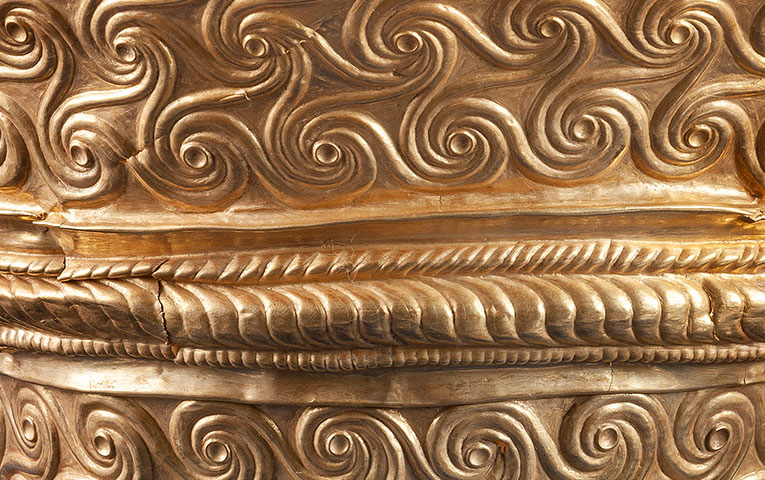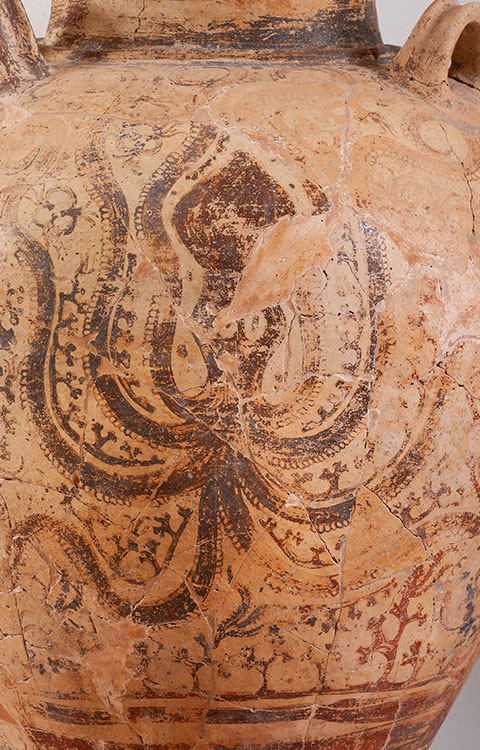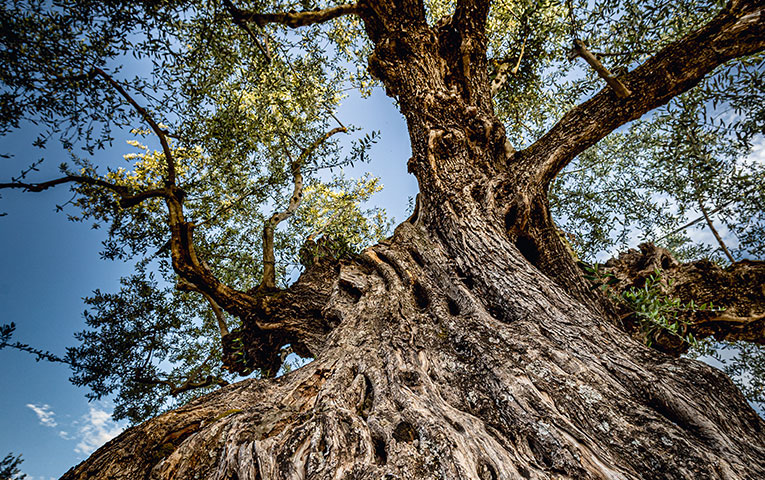
A musician seated on a rock strums her lyre as a bird flies by, in a wall painting from the throne room of Nestor’s Palace, reconstructed in watercolors by artist Piet de Jong; c. 1300 BC (Chora Archaeological Museum).
COURTESY OF THE PALACE OF NESTOR EXCAVATIONS / THE DEPARTMENT OF CLASSICS / UNIVERSITY OF CINCINNATI


Linear B tablets discovered at Nestor’s Palace are important socio-economic records listing goods such as agricultural products and crafted objects. Linear B symbols were the main source of inspiration for the visual language and branding of Costa Navarino.
© PERIKLES MERAKOS
A 1687 engraving depicting Koroni Castle, by Loschge Leonhard. First built by the early Byzantines, this fortress was later expanded by the Venetians, Franks and Ottomans.
COSTA NAVARINO ART COLLECTION

A detail from a 19th century Anatolian-style formal silk kaftan (kavadi) which was fashionable in Kalamata before Queen Amalia launched the eponymous dress that became the new national costume.
© THE VICTORIA G. KARELIAS COLLECTION OF GREEK TRADITIONAL COSTUMES

A gold drinking cup of the Keftiu-Vapheio type, adorned with flowing swirls evocative of vines or waves on the sea, from Nestor’s Palace (Chora Archaeological Museum). This is but one of the ancient motifs that inspired the graphic elements at Costa Navarino.
© GIANNIS GIANNELOS


Painted vegetal decoration on a Minoan pithoid-amphora from the Vayenas tholos tomb near Nestor’s Palace (Ano Englianos); Middle-Late Helladic, 1700-1500 BC (Chora Archaeological
Museum).
© GIANNIS GIANNELOS
An intricately woven cross on a priest’s silk vestment, from Kalograion Monastery, Kalamata. Founded in 1796, this convent gained fame for its silk-weaving industry.
© PENELOPE THOMAIDI

An extremely rare 5th-century BC bronze figurine of a mythical seahorse, one of the powerful steeds that pulled the chariot of the sea god Poseidon. It was discovered in the ‘50s by two farmers and is on exhibit at the Archaeological Museum of Messinia, in Kalamata.
© STELIOS SPYROPOULOS

Images of a griffin – a mythical creature that was part lion and part eagle – and a lion, figures influenced by Minoan art, once adorned the walls of Nestor’s Palace as symbols of power and royalty. Fragments of the original painting can be seen in this reconstruction by artist Piet de Jong (Chora Archaeological Museum). The griffin was adopted as the emblem of Costa Navarino Residences.
COURTESY OF THE PALACE OF NESTOR EXCAVATIONS / THE DEPARTMENT OF CLASSICS / UNIVERSITY OF CINCINNATI


Detail of a painstakingly restored, gold-embroidered 19th-century fermeli (traditional vest) that once belonged to Konstantinos Krontiris, a descendant of one of Kalamata’s leading families. It is a recent acquisitions of the Victoria Karelias Collection of Traditional Greek Costumes, donated by the family of Konstantinos Oikonomopoulos.
© THE VICTORIA G. KARELIAS COLLECTION OF GREEK TRADITIONAL COSTUMES
The colorful attire of Mycenaean ladies can be seen in Piet de Jong’s watercolor reconstructions of wall paintings from the Palace of Nestor (Chora Archaeological Museum).
COURTESY OF THE PALACE OF NESTOR EXCAVATIONS / THE DEPARTMENT OF CLASSICS / UNIVERSITY OF CINCINNATI


An octopus on a Late Helladic amphora, in imitation of the Minoan Marine Style; from the Mycenaean tholos tomb II at Routsi, Myrsinohori; about 1500 BC (Chora Archaeological Museum). This particular decoration is one of the many designs that inspired the Costa Navarino branding.
© GIANNIS GIANNELOS
Partial photo of a 19th-century Messinian fustanella costume, focusing on the leather belt that bears the year of its manufacture, from the Victoria Karelias Collection of Traditional Greek Costumes, Kalamata.
© THE VICTORIA G. KARELIAS COLLECTION OF GREEK TRADITIONAL COSTUMES

“Pharae today called Calamata,” a colored lithograph showing the town of Kalamata with its castle, and Mt. Taygetus rising behind; by archaeologist Baron Otto Magnus von Stackelberg, 1830. From the Costa Navarino Art Collection.

A magnificent monument to nature, this centuries-old olive tree in Vasilada has stood tall since long before Ibrahim Pasha’s army burned the southern Peloponnese in 1821. It is one of the 27 ancient trees identified by researchers from the University of the Peloponnese, as part of the pioneering project Morias 21.

